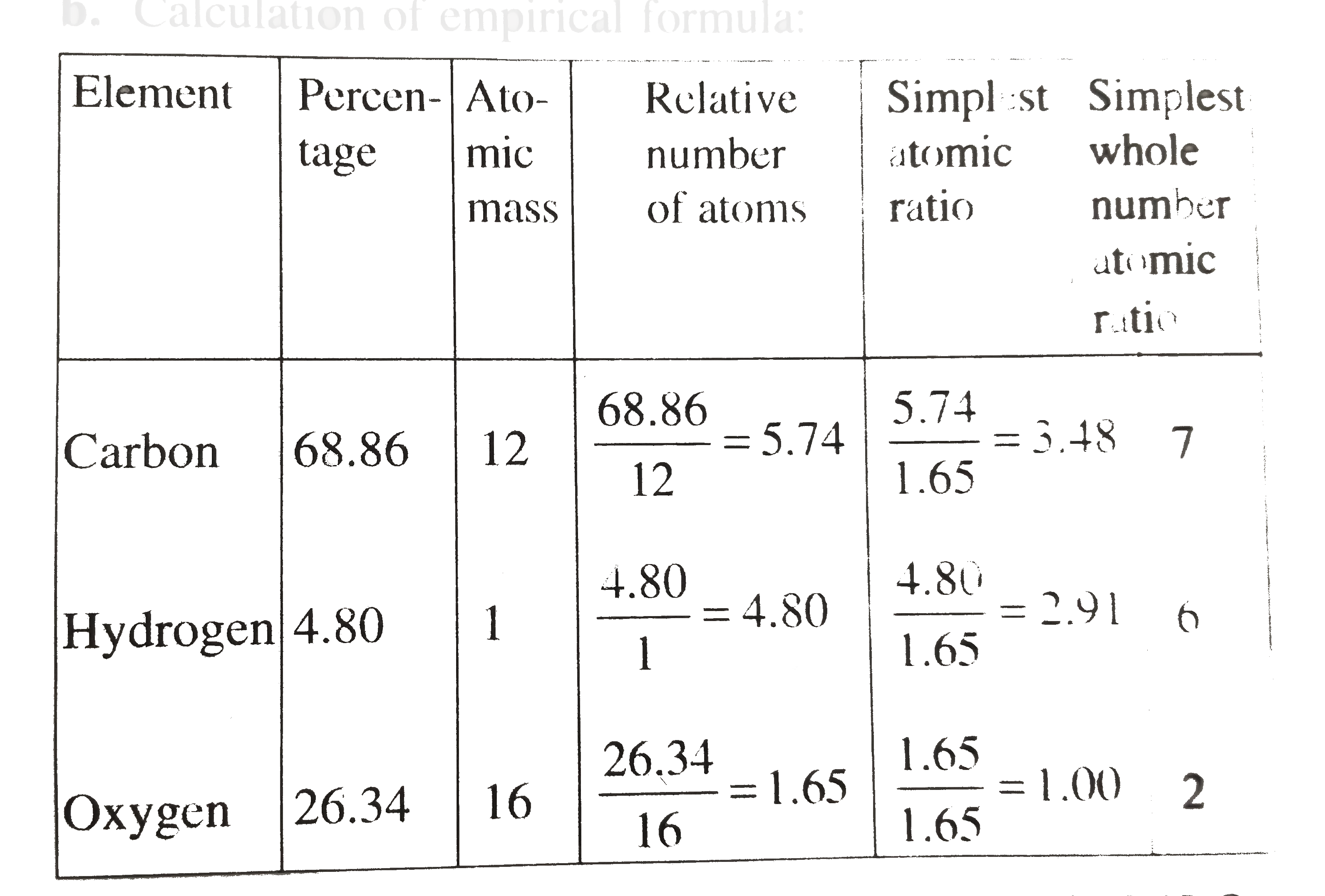0.2 g of a monobasic acid gave 0.5 g of CO2 and 0.089 g of H2O. 0.122 g of the same acid requires 10 mL of 0.1 N NaOH for complete neutralisation. Determine the molecular formula of the compound.
Calculation of percentage compression
(i). Percentage of carbon =1244×mass of CO2 producedmass of substance of taken×100
=1244×0.5050.2×100=68.86%
(ii). Percentage of hydrogen
=218×mass of H2O producedmass of substance taken×100
(iii) percentage of oxygen =100−("Percentage of "C+" percetage of H")
=100−(68.86+4.8)
=26.34%
(b).
(c) Calculation of molecular mass:
mEq. of NaOH=25×110=2.5 mEq. of acid =2.5
Equivelent of acid=2.5×10−3
equivalength of acid =
Ew=weightequivalent of acid=0.3052.5×10−3
molecular formula:
(d). calculation of molecular formula
Empirical formula (C7H6O2) mass of the compound =(7×12+6×1+16×2)=122
n=molecular massempirical formula mass=122122=1 Thus, molecular formula of the compound =n×("Empirical formula")=1×(C7H6O2)=C7H6O2

Topper's Solved these Questions
- PURIFICATION OF ORGANIC COMPOUNDS AND QUALITATIVE AND QUANTITATIVE ANALYSISBOOK - CENGAGE CHEMISTRY ENGLISHCHAPTER - PURIFICATION OF ORGANIC COMPOUNDS AND QUALITATIVE AND QUANTITATIVE ANALYSISEXERCISE - SOLVED EXAMPLES
17 Videos
- PURIFICATION OF ORGANIC COMPOUNDS AND QUALITATIVE AND QUANTITATIVE ANALYSISBOOK - CENGAGE CHEMISTRY ENGLISHCHAPTER - PURIFICATION OF ORGANIC COMPOUNDS AND QUALITATIVE AND QUANTITATIVE ANALYSISEXERCISE - Subjective Type
11 Videos
- PERIODIC CLASSIFICATION OF ELEMENTS AND GENERAL INORGANIC CHEMISTRYBOOK - CENGAGE CHEMISTRY ENGLISHCHAPTER - PERIODIC CLASSIFICATION OF ELEMENTS AND GENERAL INORGANIC CHEMISTRYEXERCISE - Exercises (Archives )Subjective
4 Videos
- REDOX REACTIONSBOOK - CENGAGE CHEMISTRY ENGLISHCHAPTER - REDOX REACTIONSEXERCISE - Archives (Integers)
1 Videos
Similar Questions
0.126 g of acid required 20 mL of 0.1 N NaOH for complete neutralisation. The equivalent mass of an acid is
View Solution0.075 g of a monobasic acid required 10 mL of N/12NaOH solution for complete neutralisation. Calculate the molecular mass of the acid
View Solution0.14 gm of an acid required 12.5 ml of 0.1 N NaOH for complete neuturalisation.The equivalent mass of the acid is:
View SolutionA monobasic acid has 68.9% C and 4.8% H. 0.122 g of acid require 10 mL of N/10 caustic soda solution for neutralisation. What is the molecular formula of the compound?
View SolutionAn organic compound contains 69.4% carbon and 5.8% hydrogen. A sample of 0.303 g of this compound was analysed for nitrogen by Kjeldahl's method. The ammonia evolved was absorbed in 50 mL of 0.05 M H2SO4. The excess acid required 25 mL of 0.1 M NaOH for neutralisation. Determine the molecular formula of the compound, if its molecular mass is 121.
View SolutionA mono acid base gave the following results :
(1) On combustion 0.20 g of the base gave 0.58 g of CO2 and 0.15 g of water.
(ii) In Duma's method, 0.3 g of it gave 32.7 mL nitrogen at 288 K and 760 mm pressure.
(iii) 0.54 g of it required 12.50 mL of 0.4 N HCl for complete neutralisation.
Determine the molecular formula of the base.
View Solution0.16 gm of a dibasic organic acid required 25.0 ml of N10NaOH for complete neutralisation. Calculate its molucular mass.
View Solution0.16 g of dibasic acid required 25 ml of decinormal NaOH solution for complete neutralisation. The molecular weight of the acid will be
View Solution0.45 gm of an organic compound gave on combution 0.792 gm of CO2 and 0.324gm of water. 0.24 gm of the same substance was Kjeldahlised and the ammonia liberated was absorbed in 50.0 ml of M8H2SO4. The excess acid required 77.0 ml of N10NaOH for complete neutralisation. Calculate the empirical formula of the compound.
View SolutionIt has been found that 0.290 g of an organic compound containing C, H and O on complete combustion yielded 0.66 g of CO2 and 0.27 g of H2O. The vapour density of the compound is found to be 29.0. Determine the molecular formula of the compound.
View Solution
